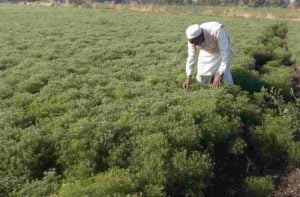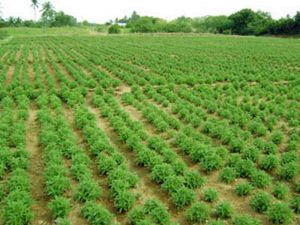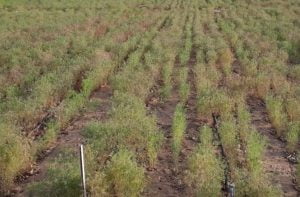Cumin is cultivated as a spice crop. Cumin is shaped like a dill. Cumin is used to flavor a variety of foods. It is used in many forms in food. Which people use in powder form and roast. Apart from food, it is also used for many stomach-related ailments.
Cumin plants need dry weather. This plant has a general need for rain. However, due to heavy rains during the ripening season, the crop loses its yield. This plant needs normal temperature for growth. In India, it is mostly grown in Rajasthan and Gujarat. Today, farmers in Rajasthan and Gujarat are making huge profits from its cultivation.
If you are also thinking of cultivating cumin, today we will give you complete information about its cultivation.
Suitable soil
Cumin cultivation requires fertile soil with proper drainage. But to get more yield it should be taken in sandy loam soil. The pH of the soil for its cultivation. The value should be normal. It should not be planted in wetlands and rocky soils.
Climate and temperature
Cumin is cultivated along with rabi crops. This is because its plants grow well from the winter season. Its plants cannot tolerate excessive heat. Its trees need very little rain. Rain falling on the trees while they are forming seeds is harmful to them. This is because rain during this period causes inflammation of the plants.
Cumin plants require different temperatures at different stages. Initially, seedlings need a temperature of about 25 degrees when sowing seeds. After that, its plants need a temperature of about 20 degrees to grow. And when flowering bees grow on trees, its plants need a temperature of 25 to 30 degrees.
Improved varieties
There are several improved varieties of cumin available. Which are designed to produce more.
R. Jade. 19
This type of cumin plant is ready for harvest about 120 days after sowing. The yield per hectare is around 10 quintals. Plants of this species do not feel irritated and inflamed. The seeds are attractive and dark brown in color.
Yes. c. 4
This variety of cumin is also called Gujarati 4. Plants of this species are ready to ripen in about 105 to 110 days after sowing. Trees of this species are of normal height. And the color of its seeds looks dark brown and shiny. The yield per hectare is about 8 quintals.
R. Jade. 223

This type of cumin seedling matures in 120 to 130 days. This type of plant does not suffer from inflammation and inflammatory diseases. Its seeds are light brown in color. The yield per hectare is 6 to 7 quintals. Its seeds contain up to 2.3% oil.
R. s 1
It is an early ripening variety of cumin. The seeds of this variety are fibrous and large in size. The yield is 6 to 10 quintals per hectare. Trees of this species are found about 5 feet in length. Plants of this species are ready to ripen in about 90 days after sowing.
R. Jade. 209
Cumin trees of this species are found to be of normal height. The yield per hectare is about 8 quintals. The seeds formed on this type of plant are thick in shape. This type of tree does not show shade disease. Plants of this species are ready to ripen in about 120 to 130 days after sowing.
G.C.1
This variety of cumin has been developed by Gujarat Agricultural University. Plants of this species are ready to ripen in about 110 days after sowing. The yield per hectare is about 7 quintals. Plants of this species are more susceptible to disease.
Farm preparation
In order to cultivate cumin, first plow the field with a rotating plow. After that leave the field for a few days. Apply appropriate amount of dung in the form of organic manure after clearing the field. Then plow the field two to three times. Run a rotavator in the field a few days after plowing. So that the soil lumps in the field are eliminated. After running the rotavator, level the field by running the pad in the field.
Method and timing of seed sowing
Cumin seeds are sown in flat soil and sown by drill. In the method of sprinkling, its seeds are sown by steaming. Therefore, before sowing its seeds, make a bed of 3 by 5 feet length in the field. The farmers then sprinkle the seeds in the prepared paddy and mix them in the soil by hand or by tooth. So the seed goes down one to one and a half centimeters in the soil. Its seeds should grow only one to one and a half centimeters below the ground. Growing below this affects germination. Its seeds are sown in rows by drill. When planting in rows, each row should have a spacing of about one foot. And a distance of about 10 to 15 cm between its seeds is appropriate in rows.

Its seeds should be processed before planting in the field. Appropriate amount of carbondozyme should be used for seed processing. 8 to 10 kg of seed is required for sowing seeds by drill in one hectare. About 12 kg of seed is required for spraying.
Cumin is cultivated along with rabi crops. In the meantime, seeds should be sown in late November for its planting. Planting later than this affects germination and yield.
Irrigation of plants
Cumin seeds are planted in dry soil. Therefore, water the field immediately after sowing. The first watering should be done slowly. This is because when irrigated in a strong current, the seed is carried away and goes to the edge. The first watering of cumin seeds should be followed by remaining water at intervals of 10 to 12 days. Five to seven irrigations are required for its seedlings to mature and mature. But when seeds are formed on the seedlings, they should not be watered. This is because irrigation during this period weakens the grain.
Fertilizer quantity
The fertilizer requirement for cumin cultivation is generally the same as for other spice crops. When preparing the field for its cultivation, 10 carts of old manure should be well mixed in the soil along with plowing. After that, while plowing the field, apply 65 kg DAP. And 9 kg urea per acre should be sprayed in the field. In addition, when watering the plants, 20 to 25 kg of urea should be given at the time of third watering during the growth of the plants.
Weed control
Weed control in cumin cultivation can be done by both chemical and natural methods. For chemical weed control, appropriate amount of Oxydergill should be mixed with water and sprayed immediately after sowing. Weeds are controlled by removing weeds from the trees in a natural way. The first seedling should be planted about 20 days after sowing. After the first pot, the rest of the pot should be done at intervals of 15 days. It is better to make two to three hens of its seedlings.
Plant diseases and their prevention
Cumin plants are prone to a variety of bacterial and insect-borne diseases. If left unmanaged, they can be left astray and lose the right path.
Moyala
It is an insect-borne disease of cumin plants. Insects of this disease cause great damage to the soft parts of plants by absorbing their sap. Outbreaks appear to be exacerbated during flowering. Outbreaks appear to be exacerbated during this time. Proper spraying of Malathion or Dimethoate on the seedlings to control the disease.
Shadow disease
In cumin trees, fungus causes shade disease. When the disease starts, a white substance appears on the leaves of the tree. As the disease progresses, the entire leaves turn white. Therefore, the plant cannot process photosynthesis and stops the growth of the plant. Apply adequate amount of soluble sulfur or carotene on the seedlings to control the disease.
Inflammatory diseases

This disease is known as blight. The disease occurs on trees due to rain or cloudy skies. In case of this disease, the upper part of the tree appears to be bent. In addition, white-brown spots appear on the leaves of trees. In case of outbreak of the disease on the plants, appropriate spray of Mancozeb or Difnocona solution should be given. In addition, when planting seeds, they should be treated with Mancozeb.
To wither
The disease appears on plants at any stage. But with the emergence of seedlings, the effect of this disease becomes more apparent. When this disease occurs, the growth of the whole plant stops. Appropriate amount of carbon dazim should be sprayed on the plants to control this disease.
Termite disease
The effect of termite disease on plants can be seen from the beginning till harvest. Termites do maximum damage to the plants by breaking the roots. So the plants are destroyed quickly. To control the disease, seeds should be treated with appropriate amount of Chloropyrifos or Quinolphos before sowing. And when the disease appears in vertical crops, appropriate amount of Chloropyrifos should be sprayed near the roots of the seedlings.
Cutting down trees
Cumin seeds are ready for harvest about 100 to 120 days after planting. During this time, the color of its seeds appears light brown. Its flower canopy should be cut and collected in the field and dried. After the flower bed dries, its grain is removed from the flower bed with the help of machine.
Income and profit
The average yield of different varieties of cumin is 7 to 8 quintals. The market price of cumin appears to be around Rs 100 per kg. Therefore, farmers easily earn 40 to 50 thousand per hectare.







